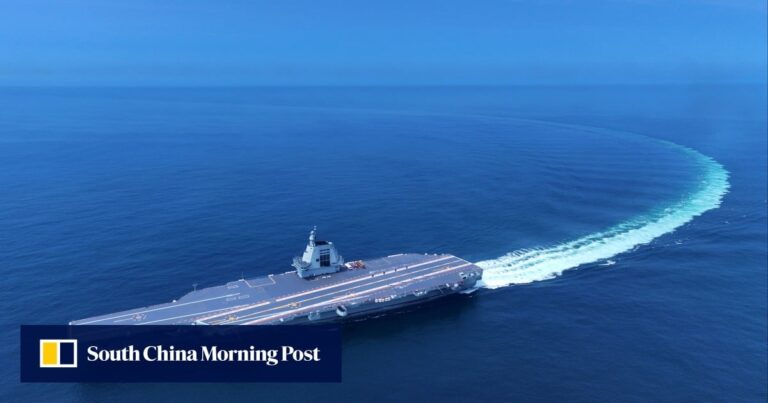“The Fujian aircraft carrier is currently known as the world’s largest conventionally-powered aircraft carrier in terms of displacement,” China Central Television said in a program broadcast on Thursday. “In a sense, the larger the displacement of the aircraft carrier, the greater its combat power.”
The Fujian, China’s third aircraft carrier and the first built from a domestic design, was launched in June 2022.
Officials said at the time that the ship’s full load displacement – a key indicator of a ship’s payload, range, speed and maneuverability – was more than 80,000 tonnes.
In terms of size, it is often compared to the retired U.S. Navy Kitty Hawk-class supercarriers, the largest of which was the USS America, with a full load displacement of approximately 85,000 tons.
The Fujian reportedly completed its second round of sea trials earlier this month, following an eight-day maiden trial voyage in May.
On Saturday, the U.S. Navy aircraft carrier USS Theodore Roosevelt arrived in South Korea for a trilateral exercise also involving Japan.
The three countries agreed to hold annual trilateral exercises at a summit last year, in which they condemned China’s “dangerous and aggressive” behavior in the South China Sea.
Taiwan’s Ministry of National Defense has also warned that Fujian would pose a “major threat” in the event of war.
China considers Taiwan part of its territory and has never renounced the use of force to regain control. Most countries, including the United States, do not recognize Taiwan as an independent country, but Washington opposes any attempt to seize the island by force and has pledged to supply weapons to Taiwan to help it defend itself.
The Fujian is China’s first aircraft carrier equipped with an electromagnetic catapult, an advancement that allows aircraft to be launched more frequently and heavier aircraft to be launched from the ship.
The USS Gerald R. Ford, the world’s largest nuclear-powered aircraft carrier with a full load displacement of over 100,000 tons, is the only aircraft carrier on the planet currently equipped with this advanced capability.
“The emergence of the Fujian not only overturns the design theory that only nuclear-powered aircraft carriers can use electromagnetic catapults, but also raises the combat capability of future domestically-built aircraft carriers to a new level,” CCTV reported.
The program said information about the Fujian’s new carrier-based aircraft would be released soon. The program also showed the Fujian making sharp turns, demonstrating how the ship effectively reduces its wake and hinders enemy weapons’ ability to locate and attack the vessel.
Military analyst Cao Weidong told the broadcaster that in some ways the Fujian’s design was “much more complicated” than a nuclear-powered vessel because it had to ensure sufficient power supply for all its equipment.
He said the warship could carry more aircraft and, thanks to electromagnetic catapults, launch fixed-wing early warning aircraft to improve flight time, radar performance and command capabilities.
The catapults would also allow the fighter jets to take off fully loaded with fuel and ammunition, reducing the need to refuel the aircraft and essentially freeing up space for more drones, transports and electronic warfare aircraft, Cao added.
He said it would take up to two years to complete testing of the Fujian aircraft carrier, adding that “the PLA Navy may build more aircraft carriers, which may be nuclear-powered.”
Cao, a former researcher at the People’s Liberation Army Navy-related Institute, also said that in future, the navy will focus on building larger ships and harnessing information technology to win wars.



